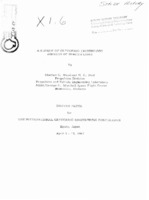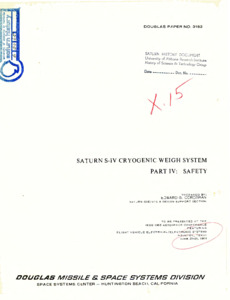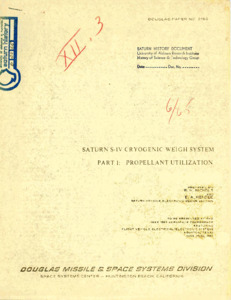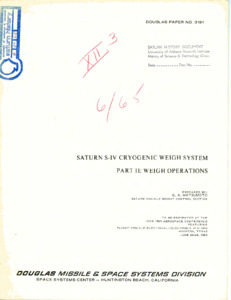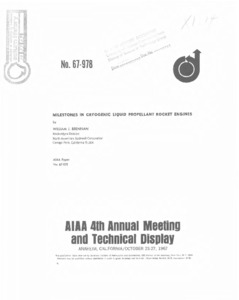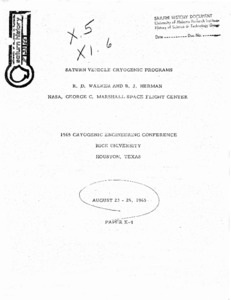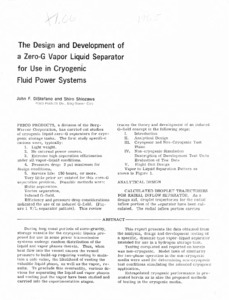
Browse Items (8 total)
Sort by:
-
"A Review of Cryogenic Technology Aspects of Space Flight."
This paper was presented at the International Cryogenic Engineering Conference in Kyoto, Japan. It details the use of cryogenic technology in rocketry and how its usage created "many new techniques and deeply stimulated many fields of cryogenic technology." -
"The development of a bonded common bulkhead for Saturn."
A Part of the development of the Saturn S-IV/S-IVB stage the Douglas Aircraft Company has pioneered in the development of the cryogenic common bulkhead. The term common bulkhead is derived from the design function of the bulkhead, which is to separate the two cryogenics, liquid hydrogen and liquid oxygen, in a single tank, thereby shortening the stage and eliminating the necessity for two separate bulkheads and the associated interstage structure. The common bulkhead is structurally adequate to withstand both the thermal and the pressure loads from both the hydrogen and the oxygen tanks, and it has sufficient insulation properties to prevent the liquid hydrogen from freezing the liquid oxygen. Another benefit from the common bulkhead is that it permits a reduction in the total length of the vehicle, thereby reducing the bending moments. -
"Saturn S-IV cryogenic weigh system. Part IV : safety."
During cryogenic weigh system operation, hydrogen when combined with oxygen can create an unsafe condition. Therefore the concentration of the residual oxygen and hydrogen from leaks in the cryogenic weigh environmental bags must be known at all times during the cryogenic weigh. Hydrogen and oxygen detectors will provide the optimum method for maintaining safe conditions. Hydrogen properties and safe mixtures are reviewed. The method selected to analyze the oxygen content is discussed. The selection, development, and testing of a hydrogen detector system is examined. -
"Saturn S-IV cryogenic weigh system. Part I : propellant utilization."
In order to achieve maximum vehicle efficiency, it is essential that the vehicle propellants be loaded to desired values and that these propellants approach simultaneous depletion at the end of powered flight. To accomplish precise loading and assure minimum residuals, a highly accurate and repeatable, vehicle located, propellant management (PM) or propellant utilization (PU) system must be used. As the ability to load propellants to predetermined values depends directly on the ability of the system to accurately sense the propellant masses, it is essential that the system be calibrated with respect to propellant mass under conditions resembling those to be experienced during final loading and powered flight. The use of a cryogenic weight system will reduce the unknown factors in capacitance sensor element shaping, tank geometry, and propellant properties to a degree which will permit the determination of propellant masses to with .025%. -
"Saturn S-IV cryogenic weigh system. Part II : weigh operations."
Two basic methods for mass determination are: (1) direct measurement, (2) volume and density determination. Both methods or variations have been used to determine space vehicle propellant mass with varying degrees of success. Stringent propellant loading accuracy requirements of k0.5 percent for the Saturn S-IV Stage have led to the development of a Cryogenic Calibration Weigh System. The method employs accurate electronic force transducers and measuring systems as the standard and experimental weighings have verified achievement of better than the required accuracy. -
"Milestones in cryogenic liquid propellant rocket engines."
This paper reviews the milestones achieved with cryogenic liquid propellant rocket engines, discusses current technology improvement programs, and projects future engine designs. During the last two decades, these cryogenic rocket engines have played a major role in rocketry and achieved numerous important milestones. These engines power the Vanguard, Redstone, Thor, Atlas, and Titan I vehicles , the Saturn I and Uprated Saturn I vehicles, and will soon be employed in the Saturn V for the Apollo missions. The requirements dictated by these vehicles have necessitated growth from the 27,000-pound-thrust Vanguard engine to the 7,600,000-pound-thrust booster cluster for the Saturn V. Gains in specific impulse have also been significant. The successful application of liquid hydrogen in the Centaur and Saturn upper-stage rocket engines was a major achievement. -
"Saturn Vehicle Cryogenic Programs."
Paper from the 1965 Cryogenic Engineering Conference at Rice University, Houston, Texas, paper K-4. The abstract states, "This paper covers the cryogenic propellant and gaseous application to the George C. Marshall Space Flight Center Saturn Programs. Emphasis is placed on the overall application and the resultant logistic considerations. The planning of facilities, storage, and transportation required to ensure an adequate supply of cryogenic fluids when needed is traced from the engine and stage requirements. The entire cycle of technical requirements, estimating the quantities required from production and management of the program is developed, spacecraft application and other trends that affect cryogenic production are reviewed." -
"Design and Development of a Zero-G Vapor Liquid Separator For Use in Cryogenic Fluid Power Systems."
During long coast periods of zero-gravity, storage vessels for the cryogenic liquids proposed for use in some power transmission systems undergo random distribution of the liquid and vapor phases therein. Thus, when heat flow into the vessel causes the vessel pressure to build-up requiring venting to maintain a safe value, the likelihood of venting the valuable liquid phase, as well as the vapor, results. To preclude this eventuality, various devices for separating the liquid and vapor phases and venting just the vapor have been studied and carried into the experimentation stages.
